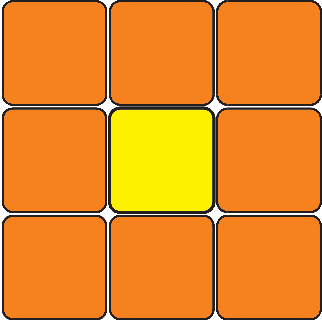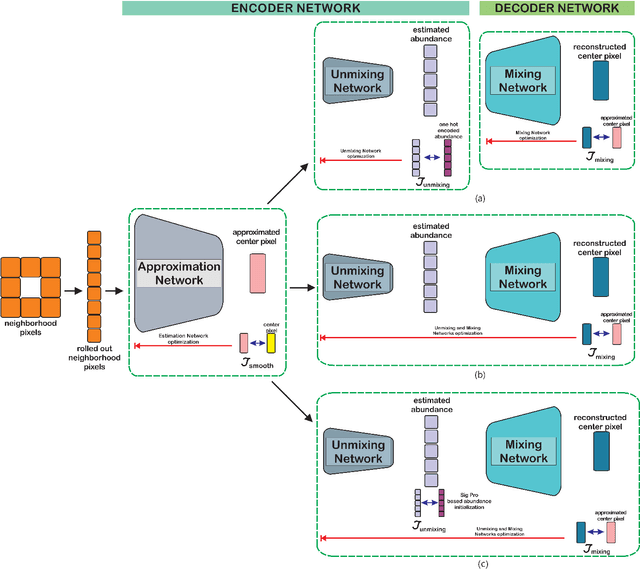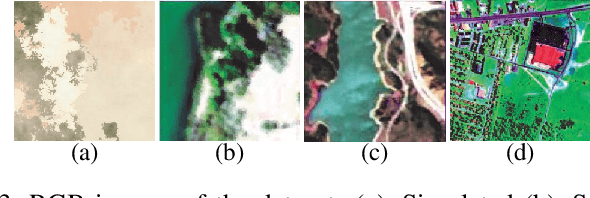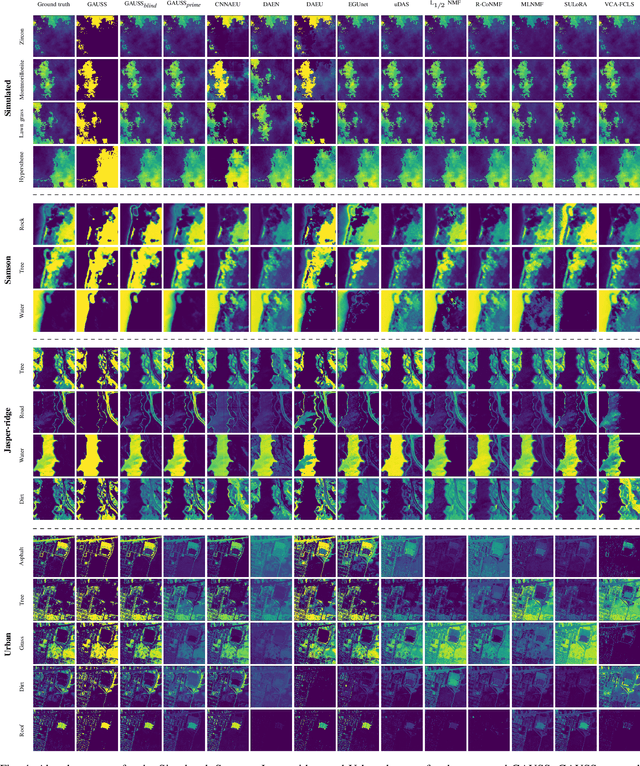Yasiru Ranasinghe
SINR: Sparsity Driven Compressed Implicit Neural Representations
Mar 25, 2025



Abstract:Implicit Neural Representations (INRs) are increasingly recognized as a versatile data modality for representing discretized signals, offering benefits such as infinite query resolution and reduced storage requirements. Existing signal compression approaches for INRs typically employ one of two strategies: 1. direct quantization with entropy coding of the trained INR; 2. deriving a latent code on top of the INR through a learnable transformation. Thus, their performance is heavily dependent on the quantization and entropy coding schemes employed. In this paper, we introduce SINR, an innovative compression algorithm that leverages the patterns in the vector spaces formed by weights of INRs. We compress these vector spaces using a high-dimensional sparse code within a dictionary. Further analysis reveals that the atoms of the dictionary used to generate the sparse code do not need to be learned or transmitted to successfully recover the INR weights. We demonstrate that the proposed approach can be integrated with any existing INR-based signal compression technique. Our results indicate that SINR achieves substantial reductions in storage requirements for INRs across various configurations, outperforming conventional INR-based compression baselines. Furthermore, SINR maintains high-quality decoding across diverse data modalities, including images, occupancy fields, and Neural Radiance Fields.
Zero-Shot Scene Understanding for Automatic Target Recognition Using Large Vision-Language Models
Jan 13, 2025



Abstract:Automatic target recognition (ATR) plays a critical role in tasks such as navigation and surveillance, where safety and accuracy are paramount. In extreme use cases, such as military applications, these factors are often challenged due to the presence of unknown terrains, environmental conditions, and novel object categories. Current object detectors, including open-world detectors, lack the ability to confidently recognize novel objects or operate in unknown environments, as they have not been exposed to these new conditions. However, Large Vision-Language Models (LVLMs) exhibit emergent properties that enable them to recognize objects in varying conditions in a zero-shot manner. Despite this, LVLMs struggle to localize objects effectively within a scene. To address these limitations, we propose a novel pipeline that combines the detection capabilities of open-world detectors with the recognition confidence of LVLMs, creating a robust system for zero-shot ATR of novel classes and unknown domains. In this study, we compare the performance of various LVLMs for recognizing military vehicles, which are often underrepresented in training datasets. Additionally, we examine the impact of factors such as distance range, modality, and prompting methods on the recognition performance, providing insights into the development of more reliable ATR systems for novel conditions and classes.
Diffuse-Denoise-Count: Accurate Crowd-Counting with Diffusion Models
Mar 22, 2023Abstract:Crowd counting is a key aspect of crowd analysis and has been typically accomplished by estimating a crowd-density map and summing over the density values. However, this approach suffers from background noise accumulation and loss of density due to the use of broad Gaussian kernels to create the ground truth density maps. This issue can be overcome by narrowing the Gaussian kernel. However, existing approaches perform poorly when trained with such ground truth density maps. To overcome this limitation, we propose using conditional diffusion models to predict density maps, as diffusion models are known to model complex distributions well and show high fidelity to training data during crowd-density map generation. Furthermore, as the intermediate time steps of the diffusion process are noisy, we incorporate a regression branch for direct crowd estimation only during training to improve the feature learning. In addition, owing to the stochastic nature of the diffusion model, we introduce producing multiple density maps to improve the counting performance contrary to the existing crowd counting pipelines. Further, we also differ from the density summation and introduce contour detection followed by summation as the counting operation, which is more immune to background noise. We conduct extensive experiments on public datasets to validate the effectiveness of our method. Specifically, our novel crowd-counting pipeline improves the error of crowd-counting by up to $6\%$ on JHU-CROWD++ and up to $7\%$ on UCF-QNRF.
GAUSS: Guided Encoder-Decoder Architecture for Hyperspectral Unmixing with Spatial Smoothness
Apr 16, 2022



Abstract:In recent hyperspectral unmixing (HU) literature, the application of deep learning (DL) has become more prominent, especially with the autoencoder (AE) architecture. We propose a split architecture and use a pseudo-ground truth for abundances to guide the `unmixing network' (UN) optimization. Preceding the UN, an `approximation network' (AN) is proposed, which will improve the association between the centre pixel and its neighbourhood. Hence, it will accentuate spatial correlation in the abundances as its output is the input to the UN and the reference for the `mixing network' (MN). In the Guided Encoder-Decoder Architecture for Hyperspectral Unmixing with Spatial Smoothness (GAUSS), we proposed using one-hot encoded abundances as the pseudo-ground truth to guide the UN; computed using the k-means algorithm to exclude the use of prior HU methods. Furthermore, we release the single-layer constraint on MN by introducing the UN generated abundances in contrast to the standard AE for HU. Secondly, we experimented with two modifications on the pre-trained network using the GAUSS method. In GAUSS$_\textit{blind}$, we have concatenated the UN and the MN to back-propagate the reconstruction error gradients to the encoder. Then, in the GAUSS$_\textit{prime}$, abundance results of a signal processing (SP) method with reliable abundance results were used as the pseudo-ground truth with the GAUSS architecture. According to quantitative and graphical results for four experimental datasets, the three architectures either transcended or equated the performance of existing HU algorithms from both DL and SP domains.
Convolutional Autoencoder for Blind Hyperspectral Image Unmixing
Nov 18, 2020



Abstract:In the remote sensing context spectral unmixing is a technique to decompose a mixed pixel into two fundamental representatives: endmembers and abundances. In this paper, a novel architecture is proposed to perform blind unmixing on hyperspectral images. The proposed architecture consists of convolutional layers followed by an autoencoder. The encoder transforms the feature space produced through convolutional layers to a latent space representation. Then, from these latent characteristics the decoder reconstructs the roll-out image of the monochrome image which is at the input of the architecture; and each single-band image is fed sequentially. Experimental results on real hyperspectral data concludes that the proposed algorithm outperforms existing unmixing methods at abundance estimation and generates competitive results for endmember extraction with RMSE and SAD as the metrics, respectively.
 Add to Chrome
Add to Chrome Add to Firefox
Add to Firefox Add to Edge
Add to Edge